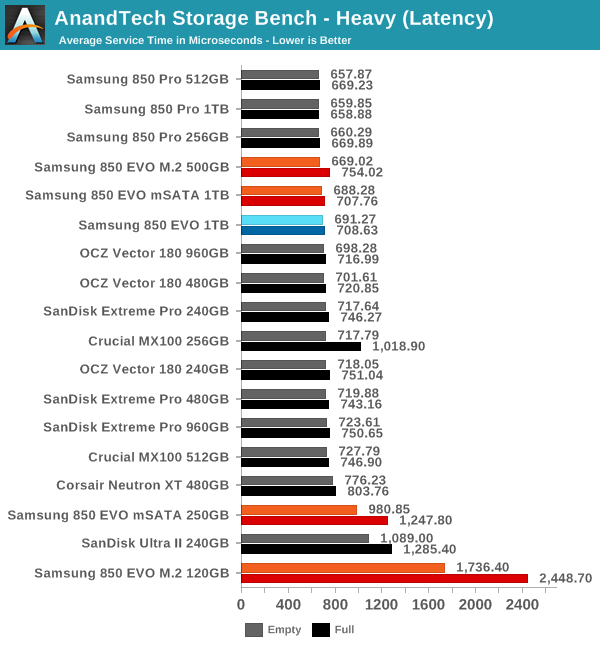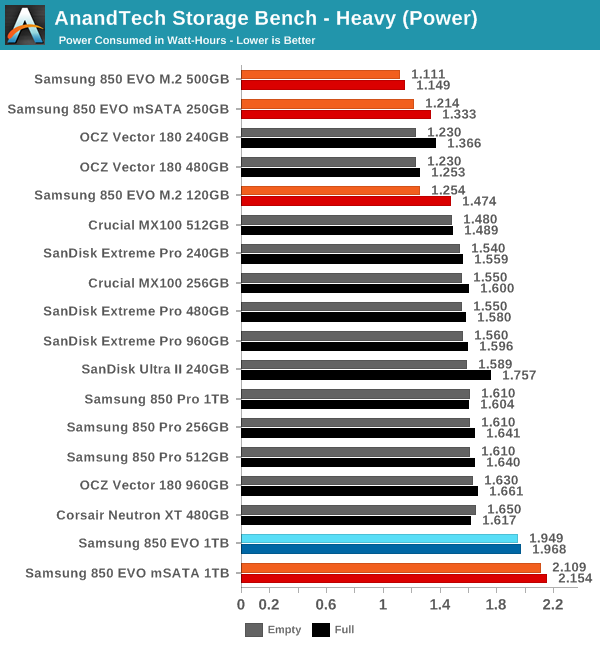The Samsung SSD 850 EVO mSATA/M.2 Review
by Kristian Vättö on March 31, 2015 10:00 AM ESTAnandTech Storage Bench - Heavy
While The Destroyer focuses on sustained and worst-case performance by hammering the drive with nearly 1TB worth of writes, the Heavy trace provides a more typical enthusiast and power user workload. By writing less to the drive, the Heavy trace doesn't drive the SSD into steady-state and thus the trace gives us a good idea of peak performance combined with some basic garbage collection routines.
| AnandTech Storage Bench - Heavy | ||||||||||||
| Workload | Description | Applications Used | ||||||||||
| Photo Editing | Import images, edit, export | Adobe Photoshop | ||||||||||
| Gaming | Pllay games, load levels | Starcraft II, World of Warcraft | ||||||||||
| Content Creation | HTML editing | Dreamweaver | ||||||||||
| General Productivity | Browse the web, manage local email, document creation, application install, virus/malware scan | Chrome, IE10, Outlook, Windows 8, AxCrypt, uTorrent, AdAware | ||||||||||
| Application Development | Compile Chromium | Visual Studio 2008 | ||||||||||
The Heavy trace drops virtualization from the equation and goes a bit lighter on photo editing and gaming, making it more relevant to the majority of end-users.
| AnandTech Storage Bench - Heavy - Specs | ||||||||||||
| Reads | 2.17 million | |||||||||||
| Writes | 1.78 million | |||||||||||
| Total IO Operations | 3.99 million | |||||||||||
| Total GB Read | 48.63 GB | |||||||||||
| Total GB Written | 106.32 GB | |||||||||||
| Average Queue Depth | ~4.6 | |||||||||||
| Focus | Peak IO, basic GC routines | |||||||||||
The Heavy trace is actually more write-centric than The Destroyer is. A part of that is explained by the lack of virtualization because operating systems tend to be read-intensive, be that a local or virtual system. The total number of IOs is less than 10% of The Destroyer's IOs, so the Heavy trace is much easier for the drive and doesn't even overwrite the drive once.
| AnandTech Storage Bench - Heavy - IO Breakdown | |||||||||||
| IO Size | <4KB | 4KB | 8KB | 16KB | 32KB | 64KB | 128KB | ||||
| % of Total | 7.8% | 29.2% | 3.5% | 10.3% | 10.8% | 4.1% | 21.7% | ||||
The Heavy trace has more focus on 16KB and 32KB IO sizes, but more than half of the IOs are still either 4KB or 128KB. About 43% of the IOs are sequential with the rest being slightly more full random than pseudo-random.
| AnandTech Storage Bench - Heavy - QD Breakdown | ||||||||||||
| Queue Depth | 1 | 2 | 3 | 4-5 | 6-10 | 11-20 | 21-32 | >32 | ||||
| % of Total | 63.5% | 10.4% | 5.1% | 5.0% | 6.4% | 6.0% | 3.2% | 0.3% | ||||
In terms of queue depths the Heavy trace is even more focused on very low queue depths with three fourths happening at queue depth of one or two.
I'm reporting the same performance metrics as in The Destroyer benchmark, but I'm running the drive in both empty and full states. Some manufacturers tend to focus intensively on peak performance on an empty drive, but in reality the drive will always contain some data. Testing the drive in full state gives us valuable information whether the drive loses performance once it's filled with data.

In the Heavy trace the 850 EVO scores highly. As I've said before, it seems that only Samsung has found the secret recipe to boost performance under SATA 6Gbps because no other manufacturer comes close to it in this benchmark.

Moving on to latency and the 850 EVO still keeps its lead compared to other manufacturers' drives. The difference is nowhere near as significant as in the throughput metric above, but the 850 EVO is still without a doubt one of the highest performing drives on the market. The smaller capacities are a bit of a disappointement, though, because the 250GB mSATA loses to MX100 by a quite hefty margin, but it still beats the Ultra II for what it's worth.

The smaller capacities, especially the 120GB one, seem to have quite a few high latency IOs. I wouldn't say the situation for the 250GB model is critical, but I do think that individuals with heavier workloads should focus on the 500GB and higher capacities in order to avoid any storage performance issues.

But in terms of power the 850 EVO is very efficient at smaller capacities. Given that mSATA and M.2 standards are mostly used in mobile applications, this is very good news.










58 Comments
View All Comments
cleverdude - Saturday, April 18, 2015 - link
Bench results have not been updated.http://www.anandtech.com/bench/SSD/65
szhosain - Monday, May 4, 2015 - link
On my Lenovo W530 laptop (about 3 years old now), I just installed a Samsung 850 EVO MSATA 1TB card, and ATTO shows me poorer numbers than seen here. About 267 MB/sec for write and 280 MB/sec for read when it peaks. My 2.5" SSD drives (from OCZ) in the same system are well over 500 MB /sec.Does this perhaps mean that the MSATA interface on this laptop is limited to 3 GB/sec rather than the 6 GB /sec on the standard SATA interfaces?
That would be quite irritating!
Ethos Evoss - Sunday, June 21, 2015 - link
When it comes to mSATA or M.2 connected to SATA III there is no point purchase stupid expensive SSDs as they will perform same as cheapest ones ..So best mSATA/m.2 SSD for SATA III use is the plextor or mushkin (i preffer plextor) which cost less and has great performance
Andrew Field - Wednesday, August 5, 2015 - link
This Samsung SSD 850 EVO mSATA constantly overheats. This is especially the case when copying large files. It rises about 10C every 30-60 seconds, and does not stop until its own overheating protection kicks in. This occurs when it is in a laptop or in an external enclosure (even when open and exposed to the air).Initially I thought I had a bad piece of hardware, but I tested 5 separate units with consistent results.
If anyone decides to test this out, I did the following:
- Step 1: Select a folder with at least 100GB of data
- Step 2: Copy said folder to a new folder (on the same Samsung SSD 850 EVO mSATA)
- Step 3: Monitored the temperature
Result: The temperature begins rising sharply in a few seconds, and does not stop rising until the SSD engages its overheating protection.
greywarden - Thursday, September 17, 2015 - link
I was about to purchase (4) 250GB 850 EVO mSATA drives to put in an Addonics quad mSATA PCIe card, but seeing the latency numbers on the drive has me concerned. Should I look into purchasing a pair of the 500GB models instead? Have the pausing and crashing problems been solved with the 1TB model yet?payamfi - Tuesday, January 19, 2016 - link
Hi guys i wanna buy a memmory for my n551jx i can not decide what to buy msata evo mini or ssd evo pro can anyone help me out?fabbrimichele75 - Friday, March 25, 2016 - link
Would it be possible to know the temperature when the disk is in idle and full load?I'm mainly interested in the M.2 version.
I'm asking because I wanted to mount it on an NUC 6i5 that seems to be sensitive to high temperature.
yolomolo - Tuesday, April 19, 2016 - link
Can i get some advice from you PRO, should i better go get mSata : Samsung EVO 850 or CRUCIAL MX200 ?